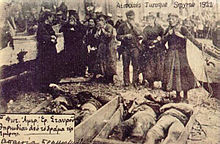| Outline of the Greek genocide | |
|---|---|
| Part of World War I, the Aftermath of World War I, and the Armenian genocide | |
 Greek civilians mourn their dead relatives, Great Fire of Smyrna, 1922 | |
| Location | Ottoman Empire |
| Date | 1913–1923 |
| Target | Ottoman Greeks |
Attack type | Deportation, mass murder, death march |
| Deaths | 300,000–900,000[1] |
| Perpetrators | Ottoman Empire, Turkish National Movement |
| Motive | Anti-Greek sentiment, Turkification, Persecution of Eastern Orthodox Christians |













Below is an outline of Wikipedia articles related to the Greek genocide and closely associated events[a] and explanatory articles.[b] The topical outline is accompanied by a chronological outline of events. References are provided for background and overview.
The Greek Genocide was the mass killings and deportations of Greeks in the Ottoman Empire by Turkish forces. It resulted in the deaths of hundreds of thousands of Greeks, including the extermination of Pontian and Anatolian Greeks, the destruction of Smyrna, and widespread ethnic cleansing in Greek areas of Asia Minor.[3]
The Greek and Armenian Genocides are considered part of the more extensive period of mass killings and ethnic cleansing of Christian populations in the Ottoman Empire at the beginning of the 20th century. Both genocides were carried out by the Ottoman government and Turkish nationalist forces and involved mass killings, forced deportations, and population transfers. The events have been recognized as a genocide by numerous countries but have not been officially recognized by the Turkish government.[4][5]
- ^ Sjöberg, Erik (2016). The Making of the Greek Genocide: Contested Memories of the Ottoman Greek Catastrophe. Berghahn Books. p. 234. ISBN 978-1-78533-326-2.
Activists tend to inflate the overall total of Ottoman Greek deaths, from the cautious estimates between 300,000 to 700,000...
- ^ "Mustafa Kemal Atatürk (1881-1938)".
- ^ Morris, B., Ze’evi, D. (2019). The Thirty-Year Genocide: Turkey's Destruction of Its Christian Minorities, 1894–1924. Harvard University Press.
- ^ Akçam, T. (2018). "The Making of the Greek Genocide: Contested Memories of the Ottoman Greek Catastrophe. By Eric Sjöberg. New York: Berghahn Books, 2017. 255 pp. Notes. Bibliography. Glossary". Slavic Review. 77 (2). Cambridge University Press: 503–504. doi:10.1017/slr.2018.151. ISSN 0037-6779. S2CID 166199078.
- ^ Meichanetsidis, Vasileios Th (2015). "The Genocide of the Greeks of the Ottoman Empire, 1913–1923". Genocide Studies International. 9 (1): 104–173. doi:10.3138/gsi.9.1.06. JSTOR 26986016. S2CID 154870709.
Cite error: There are <ref group=lower-alpha> tags or {{efn}} templates on this page, but the references will not show without a {{reflist|group=lower-alpha}} template or {{notelist}} template (see the help page).